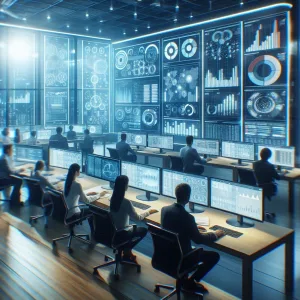Continuous monitoring is increasingly becoming an essential component of internal audit assurance work. As organizations evolve and adapt to changing business landscapes, traditional assurance methods are no longer sufficient to provide timely and effective risk management. This shift towards continuous monitoring is driven by the need for a more proactive and responsive approach to auditing, one that aligns with the dynamic nature of modern businesses [1].
At its core, continuous monitoring involves ongoing assessments and evaluations of an organization’s risks, controls, and processes. Rather than relying on periodic audits or reviews, internal auditors employ various techniques to monitor and report on key performance indicators (KPIs), control effectiveness, and risk exposure in real-time. This approach enables organizations to identify and address potential issues before they materialize into significant problems.
Traditional assurance work, which relies heavily on static audit procedures, is no longer sufficient for several reasons [2]:
- The pace of change within modern organizations has accelerated exponentially, rendering traditional methods inadequate for capturing the complexities of contemporary business environments.
- The increasing focus on governance, risk management, and compliance necessitates a more continuous and iterative approach to auditing.
The benefits of adopting continuous monitoring in internal audit are multifaceted:
- Timely Assurance: Internal auditors can provide more timely and relevant assurance to stakeholders, allowing organizations to take corrective action before losses occur.
- Proactive Risk Management: Continuous monitoring fosters a culture of proactive risk management within the organization, encouraging vigilance and responsiveness to emerging risks.
- Enhanced Technology Utilization: Internal auditors can leverage advanced technologies such as data analytics and automation tools to enhance audit efficiency and effectiveness.
Continuous monitoring is a vital component of modern internal audit assurance work. By adopting this approach, organizations can stay ahead of emerging risks, improve control effectiveness, and enhance overall risk management. For internal auditors, embracing continuous monitoring offers a chance to evolve their skills and expertise, leveraging technology to deliver more effective audit services that support the organization’s long-term success [3].
The Challenges of Traditional Assurance Work
Traditional assurance work has long been a cornerstone of internal audit functions, providing stakeholders with comfort that controls are operating effectively and risks are being mitigated. However, beneath its reassuring surface lies a complex web of inefficiencies and lack of visibility into critical control processes [4].
Key Challenges:
- Inefficiencies in Manual Processes: The need for physical audits can lead to unnecessary disruption and challenges for auditors who must manually gather and analyze data.
- Insufficient Real-Time Data: Traditional audit approaches often rely on historical data that may not accurately reflect current risk exposures, leading to potential oversights.
- Lack of Visibility: The static nature of traditional audits often fails to capture critical changes or deviations from established procedures.
To overcome these challenges, internal audit teams must adopt more forward-thinking approaches to assurance work. This may involve incorporating advanced technologies, such as robotic process automation (RPA) or machine learning (ML), to streamline processes and improve data collection efficiency.
What is Continuous Monitoring?
Continuous monitoring enables organizations to maintain ongoing assurance and risk management throughout the year. This approach shifts the focus from traditional periodic audits to a more dynamic evaluation of risks and controls. By adopting continuous monitoring, internal auditors can provide more accurate and timely insights into an organization’s risk profile [5].
Key Components:
- Real-Time Data Collection: Continuous monitoring involves the collection and analysis of real-time data to identify potential issues promptly.
- Ongoing Risk Assessment: Regularly reviewing the organization’s risk landscape and assessing the effectiveness of internal controls.
- Automated Reporting: Establishing systems for real-time reporting and notification when predefined thresholds are exceeded.
Steps for Implementation:
- Identify key risks and controls.
- Implement data collection tools.
- Develop analytics capabilities.
- Establish reporting and alerting mechanisms.
Continuous monitoring is a powerful tool for internal auditors seeking to enhance their assurance work and contribute meaningfully to an organization’s risk management efforts [6].
Benefits of Continuous Monitoring for Internal Auditors
As internal auditors, our primary goal is to provide assurance and value by assessing and mitigating risks. Continuous monitoring is an innovative technique that enables us to achieve this objective effectively.
Advantages:
- Early Detection: Continuous monitoring allows for swift identification and remediation of issues before they escalate.
- Improved Efficiency: By leveraging technology, we can streamline audit processes, reduce manual effort, and focus on high-risk areas.
- Enhanced Assurance: Continuous monitoring builds stakeholder confidence in the organization’s internal controls.
To implement continuous monitoring effectively, internal auditors must collaborate closely with risk managers and IT auditors, leveraging data analytics and automation tools.
Implementing Continuous Monitoring: Best Practices and Considerations
Implementing continuous monitoring requires careful consideration of integration with existing audit processes and tools, data quality, and stakeholder communication [7].
Best Practices:
- Integration: Align continuous monitoring with the organization’s risk management framework and KPIs.
- Data Quality: Establish guidelines for data collection and validation to ensure reliability.
- Change Management: Communicate the benefits of continuous monitoring to stakeholders and establish protocols for escalation.
By following best practices and leveraging expertise in internal audit, organizations can maintain ongoing risk assessment and control monitoring throughout the year, providing timely assurance to stakeholders.
Conclusion: The Future of Assurance Work with Continuous Monitoring
In conclusion, continuous monitoring has the potential to revolutionize assurance work in internal audit. By implementing this approach, organizations can align risk management with strategic objectives and identify potential risks in a timely manner.
Internal auditors must be willing to adapt their approaches and embrace continuous monitoring as the new standard for assurance work. By doing so, they can help organizations navigate complex risks and maintain compliance, ultimately driving greater value for their organizations.
FAQ: Common Questions About Continuous Monitoring
Q1: What is the primary goal of continuous monitoring in internal audit?
A1: The primary goal is to provide ongoing assurance and timely insights into an organization’s risk profile, enabling proactive risk management.
Q2: How does continuous monitoring differ from traditional auditing?
A2: Continuous monitoring focuses on real-time assessments and ongoing evaluations, while traditional auditing relies on periodic reviews.
Q3: What technologies are commonly used in continuous monitoring?
A3: Technologies such as data analytics, robotic process automation (RPA), and machine learning (ML) are commonly utilized.
Q4: How can organizations ensure data quality in continuous monitoring?
A4: Organizations can establish clear guidelines for data collection, validation, and regular review cycles to maintain data integrity.
Key Takeaways
- Continuous monitoring enhances assurance work by enabling real-time insights and proactive risk management.
- Internal auditors must adapt their methodologies to leverage technology and data analytics effectively.
- Collaboration across departments is essential for successful implementation and ongoing monitoring.
By embracing continuous monitoring, internal auditors can significantly enhance their assurance work, providing greater value and support to their organizations.
Find out more about Shaun Stoltz https://www.shaunstoltz.com/about/
This post was written by an AI and reviewed/edited by a human.



